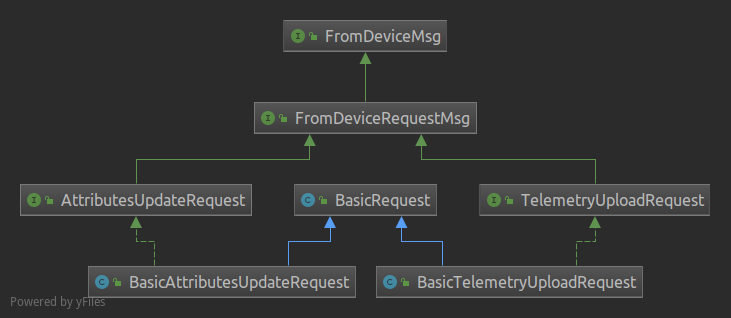-
Notifications
You must be signed in to change notification settings - Fork 1.1k
物模型
物模型是对设备在云端的功能描述,包括设备的属性,数据,服务和事件。
物联网平台通过定义一种物的描述语言来描述物模型,称之为 TSL(即 Thing Specification Language),采用JSON格式,您可以根据TSL组装上报设备的数据。
最终能达到的效果:
-
识别JSON中的键值内容,默认情况下,Key始终是一个字符串,而value可以是String,boolean,double或long。
-
解析识别JSON字符串和JSON数组类型的字符串
-
解析识别带有毫秒精度的unix时间戳的JSON字符串
效果如下:
使用序列化框架GSON对JSON格式的键值对进行识别解析,可以通过引入com.google.code.gson来配置关系。
<dependency>
<groupId>com.google.code.gson</groupId>
<artifactId>gson</artifactId>
</dependency>在KvEntry中提供了获取键值对属性的基本接口,例如获取字符属性的键,值和获取字符串,布尔型和数字类型的接口方法。BasicKvEntry定义了键只能为字符串类型,LongDataEntry,BooleanDataEntry,DoubleDataEntry和StringDataEntry分别定义了相应属性的值。
public interface KvEntry extends Serializable {
String getKey();
DataType getDataType();
Optional<String> getStrValue();
Optional<Long> getLongValue();
Optional<Boolean> getBooleanValue();
Optional<Double> getDoubleValue();
String getValueAsString();
Object getValue();
}通过将来自设备的消息根据类型划分为设备属性(AttributesUpdateRequest)和设备上传数据(TelemetryUploadRequest),
其中TelemetryUploadRequest包含了Long型的unix时间戳。
属性识别解析如下,上传数据解析识别类似
UML 时序图如下:
public class JsonConverter {
private static final Gson GSON = new Gson();
public static final String CAN_T_PARSE_VALUE = "Can't parse value: ";
//遍历键值属性,对相应键值进行处理
public static List<KvEntry> parseValues(JsonObject valuesObject) {
List<KvEntry> result = new ArrayList<>();
for (Map.Entry<String, JsonElement> valueEntry : valuesObject.entrySet()) {
JsonElement element = valueEntry.getValue();
if (element.isJsonPrimitive()) {
JsonPrimitive value = element.getAsJsonPrimitive();
//如果值为字符串
if (value.isString()) {
//新建StringDataEntry
result.add(new StringDataEntry(valueEntry.getKey(), value.getAsString()));
//如果值为布尔型
} else if (value.isBoolean()) {
//新建BooleanDataEntry
result.add(new BooleanDataEntry(valueEntry.getKey(), value.getAsBoolean()));
//如果值为数值类型
} else if (value.isNumber()) {
parseNumericValue(result, valueEntry, value);
} else {
throw new JsonSyntaxException(CAN_T_PARSE_VALUE + value);
}
} else {
throw new JsonSyntaxException(CAN_T_PARSE_VALUE + element);
}
}
return result;
}
private static void parseNumericValue(List<KvEntry> result, Map.Entry<String, JsonElement> valueEntry, JsonPrimitive value) {
//数值转化为字符串类型,并判断是不是包含".",来判断是Long,还是Double
if (value.getAsString().contains(".")) {
result.add(new DoubleDataEntry(valueEntry.getKey(), value.getAsDouble()));
} else {
try {
long longValue = Long.parseLong(value.getAsString());
result.add(new LongDataEntry(valueEntry.getKey(), longValue));
} catch (NumberFormatException e) {
throw new JsonSyntaxException("Big integer values are not supported!");
}
}
}
public static AttributesUpdateRequest convertToAttributes(JsonElement element) {
return convertToAttributes(element, BasicRequest.DEFAULT_REQUEST_ID);
}
public static AttributesUpdateRequest convertToAttributes(JsonElement element, int requestId) {
if (element.isJsonObject()) {
BasicAttributesUpdateRequest request = new BasicAttributesUpdateRequest(requestId);
long ts = System.currentTimeMillis();
//将JSON字符串解析为键值属性的集合
request.add(parseValues(element.getAsJsonObject()).stream().map(kv -> new BaseAttributeKvEntry(kv, ts)).collect(Collectors.toList()));
return request;
} else {
throw new JsonSyntaxException(CAN_T_PARSE_VALUE + element);
}
}
}
准备工作:
安装Docker
我已经将此工程制作成镜像,并上传到DockerHub上。
🌟 🌟🌟
- 从DockerHub下载sanshengshui/iot-guide-tsl镜像
docker pull sanshengshui/iot-gui-tsl 2. 后台运行iot-guide-tsl,并将镜像端口80080映射到本机的8080
docker run -d -p 8080:8080 sanshengshui/iot-guide-tsl
利用curl测试接口
curl -v -X POST -d '{"key1":"value1", "key2":true, "key3": 3.0, "key4": 4}' http://localhost:8080/api/v1/tsl --header "Content-Type:application/json"
This article is part of the IOT Technical Guide, click on Directory View all chapters.
If you feel that the article is helpful to you, please click on Star 🌟 or Fork 🍴 in the top right corner.




